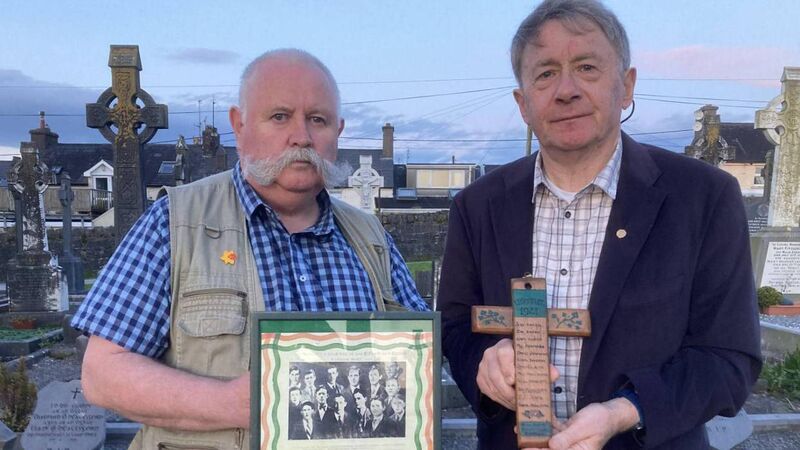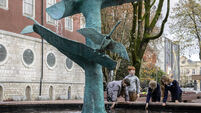Remarkable history of a cross bought at a Cork car boot sale

A Committee was formed to oversee fundraising as the costs involved were huge. We were still in the punt era until 1999 and several hundred thousand punts were needed, and the same in euros in subsequent years.
Raffles, Race Nights, American Tea Parties, Special Collections, Card Drives and Concerts were just some of the events organised. In fairness, the response was just magnificent but, of course, the fund-raising had to continue over many years.
One night at a meeting a local man suggested: “What about a Car Boot Sale?” Heads were turned as no-one had ever heard of such a thing.
The explanation was given that people would come to a central location and sell unwanted goods and chattels from the boot of their car or van, and people would pay to come and look and maybe buy the goods on offer.
Heads were shaken and doubts cast - “Yerra, that would never take off round here.” Anyhow, it was agreed to give it a go and, as they, say, the rest is history.
That was back in 1997 and, except for the Covid years, the Rathcormac Car Boot Sale has continued ever since - more than 2,000 people attended last Sunday!
Some sellers and buyers never miss the monthly sale, whilst many others from all over Munster and beyond might come five or six times a year.
They say in some old country store you could buy anything from a needle to an anchor - ’tis the same at a Car Boot Sale. People with a good eye for antiques can pick up bargains - one man’s rubbish is another’s treasure. Many an item might be sold two or three times on the one day!
About five years ago, Eugene Power, from Midleton, was at the Car Boot Sale in Rathcormac. He served for over 30 years with the Irish Defence Forces and took part in eight overseas tours of duty. He has a keen interest in all things military and collects memorabilia connected with armies from across the world.
On this particular Sunday, a dealer, John was his name, was chatting with Eugene and said: “I have something here that you might be interested in.” John picked up a little wooden cross about 12 inches in length. Eugene took it and saw that 12 names were inscribed on the cross and ‘Clonmult 1921’ on the top.
Being an East Corkman and keen historian, Eugene realised that this little wooden cross was some kind of memorial dedicated to the 12 IRA Volunteers killed by British Forces at Clonmult on February 21, 1921.
Normally, it would be items more associated with military engagement that Eugene would purchase, but immediately he thought of someone that would really value this simple wooden cross.
A quick phone call to his friend Tom O’Neill resulted in Eugene asking John to “hold onto the cross for an hour’”. John agreed and Tom was quickly in Rathcormac.
He was excited and thrilled to be able to purchase the cross as Tom has a huge interest in Clonmult and what happened there on that fateful Sunday in early 1921. He has written two books on the Battle of Clonmult.
So, Tom O Neill, historian and author, took into his possession a unique link dating back over a century.
Who carved the cross? Well that quickly came to light as on its reverse was the ‘signature’ of the maker, Thomas Mullins - using the Irish version of his name O Maolain - and the legend that the cross was made in the Ballykinlar Detention Camp in Co. Down.
Mullins has a fascinating background. He was born in New York on February 12, 1903, and because February 12 was also the birth-date of US President Abraham Lincoln, young Mullins - his father Martin was from Cork and mother Catherine from Galway - was christened Thomas Lincoln Joseph Mullins.
Thomas went to school in Kinsale and then went to Padraig Pearse’s St Enda’s in Dublin. As a young man he joined the IRA and was arrested and imprisoned, initially in Spike Island and later sent to Ballykinlar.
Up to 2,000 Republicans were detained in the Co. Down camp in 1921. One can imagine the sorrow and grief that swept through the ranks of these men in the aftermath of Clonmult when news filtered through that 12 of their comrades were shot dead in the attack on the farmhouse in East Cork.
In the memory of those slain on that blood-stained Sunday, Mullins fashioned the cross from two pieces of wood. The 12 shot are named in alphabetical order; Jerh Ahern, Jim Ahern, Liam Ahern, Ml. Desmond, David Desmond, Donal Dennehy, James Glavin, Ml. Hallahan, Richd. Hegarty, Jos. Morrissey, JJ Joyce and Chris. Sullivan.
Poignantly, two more names were later inscribed on the reverse of the cross. Patrick O’Sullivan and Maurice Moore, both from Cobh, were arrested at Clonmult on the day of the carnage, subsequently court-martialled, and executed on April 28, 1921, at the Cork Detention Barracks - next Sunday marks their anniversary.
Thomas Mullins was a friend of Éamon de Valera. He was a founder of Fianna Fáil in 1926 and returned as a TD for West Cork in the June and September 1927 General Elections.
He didn’t contest the 1932 election but ran unsuccessfully in the Carlow-Kildare constituency in 1943 and 1944. A journalist with The Irish Press, he contested a by-election in Dublin in 1947 where Clann na Poblachta’s Sean Mac Bride was elected.
Mullins was a Taoiseach’s nominee in Seanad Eireann from 1957 until 1973. He died in 1978 and was buried in Deans Grange cemetery.
We will probably never know where the little wooden cross fashioned in Ballykinlar camp in early 1921 was for over 90 years. Thankfully, Eugene Power was at that car Boot Sale in Rathcormac a few years back and was able to contact Tom O Neill.
Such twists of fate are simply unexplainable, but I dare to think the spirit, the influence and the legacy of the 12 who fell at Clonmult still lives on.
On Sunday next, when tens of thousands will be roaring for Cork and Clare on the banks of our own lovely Lee, I’ll be thinking of Maurice Moore and Patrick O Sullivan, 103 years after they were executed.
Their mortal remains lie in the grounds of Cork Male Gaol, off Western Road, now part of UCC, alongside the other IRA men executed in Cork during 1921.
Ah yes, it’s just a simple little wooden cross, but what a story it tells.







 App?
App?







